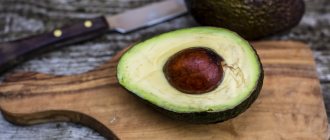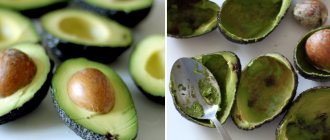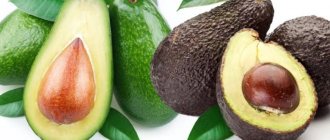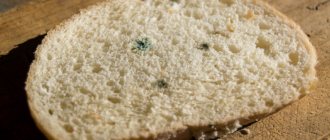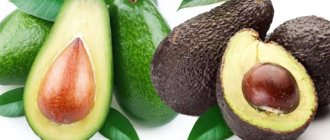Avocados don't start to ripen until they're picked from the tree, but the process happens pretty quickly after that.
Once ripened, you have a narrow window of time—usually a few days—before the fruit begins to spoil (1).
You may be wondering how to tell when an avocado has gone bad and is no longer ready to eat.
Here are 5 signs that your avocado has gone bad.
How do you know if an avocado has gone bad?
Overly soft with bruised skin
When checking for ripeness, use the palm of your hand to gently squeeze the avocado. Do not press the fruit with your fingers as this may damage the flesh.
If the avocado is very hard and cannot be pressed at all, it means it is unripe. If it gives a little, it's probably ripe and ready to eat.
However, if squeezing leaves small indentations, the fruit may be too ripe to cut and would benefit from being pureed.
The fruit is overripe and probably spoiled, perhaps if pressure leaves large dents and the fruit becomes soft.
Also, if the avocado already has dents before you squeeze it, it's probably already started to go bad (2).
If you gently squeeze an avocado in the palm of your hand and it forms large indentations where you pressed, the fruit is overripe and likely spoiled.
How to choose an avocado
Ripe avocado:
- when pressed, a small dent formed;
- the flesh is bright green;
- When you shake the fruit, you can hear the sound of the stone.
Unripe avocado:
- when pressed, a large dent formed or did not form at all;
- hard fruit;
- yellowish flesh;
- When shaking the fruit, the sound of the stone is not heard.
Leave a comment (0)
Blackened peel
Some avocados undergo distinct changes in skin color as they ripen, especially the Hass variety, which accounts for about 80% of avocados eaten worldwide (3).
When Hass avocados are not fully ripe, they have a bumpy, bright green skin. When ripe, it turns dark green or brown. If the skin looks almost black and the fruit feels soft when touched, it is overripe and probably spoiled.
Other varieties, including Zutano and Fuerte, retain their green skin color no matter how ripe they are. Use other methods, such as feeling for firmness, to determine whether they are ripe or spoiled.
Hass, the most common variety of avocado, has blackened skin when overripe or spoiled. However, other varieties retain their green color when overripe.
Why do avocados become darker?
The brown zone theme in avocado is all about aesthetics.
As we know, there are many fruits that turn dark gray or brown when peeled or crushed.
When the skin is cut or removed, its cellular structure is damaged. And then the fruit is exposed to oxygen in the air, which “collides” with the phenolic compounds of the avocado, forming a different color.
This is similar to a defense system and is known as oxidation.
This does not mean that it becomes inedible, but its appearance is undesirable.
We see something similar in bananas or apples.
Luckily, there are some natural tricks that can help prevent avocados from oxidizing, keeping them green longer.
So you can save it even if it's not completely used up.
Dark, striped flesh
Once you cut an avocado, it's much easier to tell if it's gone bad. Of course, this option is only suitable if you have already bought the fruit.
Avocados that are ready to eat have light green flesh. Rotten pulp has brown or black spots (2).
However, an isolated brown spot may be due to dents rather than widespread deterioration and can be cut off.
Another possible sign of rotting is dark streaks in the flesh.
However, some avocados, especially those picked from young trees, may have dark streaks even if they are not rotten. If the fruit looks good and does not taste bad, it is safe to eat.
Likewise, the texture of an avocado can be uneven when it's spoiled. However, if there are no other signs of rot, this is not necessarily a bad thing. The fibrous texture can also be attributed to growing conditions (2).
The avocado has darkened, can it be eaten if the avocado flesh has darkened?
The avocado pulp inside has darkened and is covered with black dots.
What to do to prevent avocados from turning brown?
Is it possible to eat an avocado that has darkened inside?
Even more than a darkened avocado, you should be afraid of an unripe avocado. I learned about this quite recently from a TV show in the genre “Rospotrebnadzor” or “Test Purchase”.
It also has a poisonous pit, as it turned out, it is important not to cut or accidentally damage it when cutting the avocado.
Ignorance is also strength - I ate both darkened and frankly hard (and therefore unripe). You cut an avocado, and it’s darkened, more precisely in the dots, so don’t throw it away. Or it seems soft, you cut it and only then realize it’s underripe.
By taste or smell
Ripe avocados have a pleasant, slightly sweet aroma and a slightly nutty taste. As the fruit spoils, its taste and smell may deteriorate.
If it tastes or smells sour, it may have bacterial spoilage and should be discarded (2).
A chemical smell and taste may mean it is rancid. This can happen when oxygen or microbes damage or break down the unsaturated fat in the fetus (4).
Rancidity can lead to the formation of potentially toxic compounds. Don't eat an avocado if you think it's rancid (5).
The taste of spoiled avocados can vary, but it's usually easy to tell if they've gone bad based on the taste.
You can tell if an avocado has gone bad by smell, taste, touch, and visual inspection.
A sour taste or smell, as well as a rancid aroma and chemical taste mean the avocado is spoiled and you should discard it.
How to avoid browning of avocados?
There are several ways to avoid oxidation of the avocado cut due to contact with air. It is recommended to lubricate the cut of the fruit:
- vinegar;
- fresh lemon juice;
- olive oil.
You can also use cling film or a container with an airtight lid. These measures will prevent the avocado cut from oxidizing when exposed to air, and the flesh will not change color.
Many people are also interested in whether it is possible to eat an avocado if it is brown inside around the pit. The brown pulp surrounding the pit is a putrefactive change common to overripe fruits. An overripe avocado begins to spoil in the middle. In this case, it is not worth eating.
Mold
Mold on avocados is usually white or gray and has a fuzzy appearance. Do not inhale it, as you may inhale mold spores and cause breathing problems if you are allergic to it.
Avoid buying avocados with mold on the outside, as it can penetrate into the flesh and cause the entire fruit to spoil.
If you cut an avocado and see mold, discard the entire fruit. Although you may only see mold in one area, it can easily spread through the pulp. Do not try to save the fetus (6).
Mold is a clear sign that the avocado has gone bad. You should discard the entire fruit as mold may spread through the flesh but may not be completely visible.
How to make avocado sauce
- Cooking time: 15 minutes.
- Number of servings: 1.
- Calorie content of the dish: 180 kcal.
- Purpose: sauces.
- Cuisine: Georgian.
- Difficulty of preparation: easy.
How can it be delicious if the fruit itself is tasteless? How could he! Avocado-based sauce is easy and simple to make and can be served with any dish. You can spread it on bread instead of butter or highlight the extraordinary taste of a not very appetizing dish. The bright color of the sauce beautifully decorates ordinary food.
Ingredients:
Cooking method:
- Cut the fruit into two parts, remove the pit and pulp, and chop.
- Add lemon juice and remaining ingredients.
- Grind and pour into a gravy boat.
Vegan for pasta
- Cooking time: 15 minutes.
- Number of servings: 2 persons.
- Calorie content of the dish: 199 kcal.
- Purpose: vegan.
- Cuisine: Georgian.
- Difficulty of preparation: easy.
Tired of fatty dishes for dinner? Cook spaghetti with a rich avocado cream sauce. The salad color will highlight the delicious dish. Creamy fruit pulp with the sourness of lemon - what could be tastier?
Ingredients:
Cooking method:
- Peel ripe fruit, discard the pit, and scoop out the pulp with a spoon.
- Cut into large cubes with a sharp knife.
- Grind with other products.
Safety of overripe avocados
Whether an overripe avocado is safe to eat depends on the type of decomposition and how long it remains overripe.
Since ripening begins at the end of the stem and progresses downwards, you can use part of the overripe fruit if the flesh has just begun to brown.
However, do not eat the discolored parts of the avocado as they will not taste good. Also, don't try to salvage any part of a rancid, sour-smelling, or moldy avocado, as it may make you sick (2, 5, 6).
Keep in mind that once you cut an avocado, the flesh will begin to brown due to exposure to oxygen. This is a natural process similar to how apples turn brown when sliced. If you find it unappetizing, peel off the brown layer and eat the rest (7).
To minimize darkening of cut areas, brush the pulp with lemon juice and store in the refrigerator in a sealed container.
By keeping an eye on your avocado and storing it in the refrigerator to slow down the ripening process, you can reduce waste.
Overly soft but unspoilt avocados are safe to eat and can be used in guacamole, smoothies, salad dressings and baked goods.
If an overripe avocado tastes great, you can eat it, but be sure to avoid spoiled ones. The more an avocado deteriorates, the more likely it is to become rancid or moldy, which can make you sick.
Avocados are grown in areas with tropical and subtropical climates. After harvesting, the fruits do not immediately reach store shelves. During transportation, part of the harvest spoils, so owners often collect unripe fruits. Violation of storage or transportation conditions can lead to loss of taste and change in structure. Whether an avocado is black inside or not is a question that worries consumers who choose vegetables and fruits in supermarkets and retail outlets.
The benefits and harms of avocados for the body
Dark green fruits with a rough skin and a pit inside contain fiber, potassium, vitamins B, K, E, C (one fruit contains 50% of the norm), as well as folic acid (it reduces the risk of congenital anomalies in the unborn child).
The pulp of a ripe avocado has a delicate, oily consistency with a high content of vegetable fats and tastes like a walnut.
In terms of nutrients and minerals, avocados can be compared to pharmacy multivitamins.
This rich chemical composition of avocado lowers cholesterol levels in the blood, strengthens the immune system and bones, helps lose weight, normalizes blood circulation, and increases performance.
In the summer, one of the most popular and healthy drinks is an avocado smoothie with almond milk. Photo: Restaurant Christian
However, the overseas fruit is not only useful, but also has contraindications. Who shouldn't eat avocado?
- Firstly, for allergy sufferers. Especially those who have a strong reaction to citrus fruits. Experts recommend that such people either first take a test for tolerance to the fruit, or include it in the diet gradually, observing the body.
- Secondly, people suffering from gastrointestinal diseases should refrain from eating avocados. In this case, it is also recommended to consult your doctor. Avocados are high in fat, which can negatively affect the digestive system.
- Thirdly, diabetics should treat avocados with caution - 100 grams of this product contains approximately 8.5 grams of carbohydrates.
You can prepare a large number of delicious dishes from avocados, but before eating this overseas fruit, you first need to find out if you are allergic to it. Photo: Restaurant “Syrovarnya”
What are black spots inside an avocado?
The appearance of black dots inside is associated with technical ripeness. Ripeness is determined by several criteria:
- the mark from light pressure quickly disappears, the shell takes its previous shape;
- the area where the cutting was located becomes green, with brown spots;
- when pressing on the handle, the oil accumulated inside may seep out;
- when shaking inside, you can hear the tapping of the bone;
- The bone is easily separated from the pulp: it can be removed with a spoon.
The appearance of the peel will not say anything about the ripeness or safety of the pulp inside. Depending on the variety, the peel has green, brown and intermediate colors.
Whether an avocado can be eaten can be determined by the color and structure of the pulp. If the pulp is covered with black dots inside, this may indicate a violation of storage rules. The appearance of black spots occurs due to the fact that the fruit was first stored in a cold room, and then it gets into the heat.
The answer to the question whether it is possible to eat pulp with black dots inside also depends on how much blackness is spread over the surface. If the black spot is located far from the seed and the area covered by it is approximately 10% of the total, then such fruit can be removed by first removing the black spots with a spoon. Small black dots are picked out with the sharp tip of a knife, and then the pieces of pulp are used for their intended purpose. Such pieces will not taste bitter or have any other unpleasant taste.
If the black spot completely surrounds the pit on both halves, and when removed it turns out to be widespread at all levels within the pulp, then the fruit should not be eaten. In this case, there are several reasons for the appearance of black spots:
- sudden change in climatic conditions during storage;
- long stay at low temperatures;
- violation of transportation methods;
- possible stay in water and subsequent drying.
A black spot is evidence of overripeness. With maximum spread, it threatens the fruit with loss of taste and beneficial properties. It is better not to eat such fruit, since, most likely, it will taste bitter and, in addition, will lose its beneficial properties.
Avocado
The beginning of the 1980s gave birth to a significant movement - the anti-fat campaign. The United States Department of Agriculture (USDA) issued dietary guidelines, and health institutes urged Americans to reduce their cholesterol intake. That same year, the government spent $150 million on a study that showed that eating fat increases the risk of heart attack. In his article for Time, Brian Welsh writes that scientists were wrong when they declared fat as enemy number one.
But the biggest example of extreme marketing is the avocado story.
Photo Getty Images / Photo Getty Images
The story of how the avocado went from being a little-known alligator pear on the West Coast to becoming a top-selling fruit stems from years of work by the Hill & Knowlton PR team to put avocados on menus around the world, increase sales, and spread the product across the planet. There were many problems along the way: manufacturers could not imagine how to sell a product with the unappetizing name “alligator pear,” how to get people to eat the unsweetened fruit with a slippery texture, and what and when to eat it with.
Issues were resolved as they were received. They decided to rename the alligator pear into something simpler - avocado. At the same time, nutritionists emerged obsessed with the idea of including large amounts of the “right” fats in the diet. New trends have appeared in the world of proper nutrition: keto and paleo diets, pegan (a hybrid between paleo and vegan). The keto diet involves a low-carbohydrate diet with an advantage of fats and a moderate amount of protein in the diet. Healthy fats have never been more in demand than they are now.
It is obvious that all the efforts of the campaign organizers were not in vain.
Avocado recently took the top spot in America's fruit baskets. In the 1990s, the average American ate about 5 pounds of the fruit, and in 2012, avocado sales increased fivefold. For comparison: during the same period, the consumption of fresh apples decreased by 0.2 kg. How did it happen? Watch the cartoon "Teen Titans Go!"
Fans of healthy eating began to open cafes and restaurants dedicated to avocados; souvenirs, clothing and interior items depicting a green fruit with a brown “belly” are actively produced and sold. Instagram is full of photos of a breakfast that many people love: toast with avocado, salmon and a poached egg. The food trend has already appeared in recipes for all dishes: from drinks to desserts.
Avocados have a well-founded image as the healthiest product. It has a lot of vitamins, fiber, no sugar at all and a lot of “good” fat. However, not everything is as clear as it might seem. Not all yogurts—oops, sorry—fat are created equal. "Consuming too much of the fruit can lead to excess weight due to the fat content in avocados, even though it is unsaturated," San Diego-based nutritionist Lara Flores told LiveScience. The authors of the Stylecraze portal claim that consumption of this fruit may be unsafe for young mothers. And people with so-called latent allergies should generally stay away from the green fruit, as the Mayo Clinic calls for.
In the summer of 2022, publications appeared online about how a number of cafes and restaurants were abandoning avocados. The Independent interviewed two English restaurant owners, Wild Strawberry Cafe and Tincan Coffee Co. You can no longer have avocado toast for breakfast in these places - their owners believe that transporting avocados from other continents causes a large ecological footprint on the planet. Avocado planting involves cutting down forests and using large amounts of chemicals, and the fast-growing business attracts unscrupulous investments. Mexican Greenpeace saw a problem with avocados back in 2016: “Transporting the fruit to other countries requires large volumes of agricultural chemicals and wood. These factors can affect the environment and human well-being.” In May of this year, the manager of the Richter restaurant, Evgeniy Shchur, and I discussed the supply of vegan ice cream for the largest club “Mutabor” (Arma17, Outline), the condition of their management is the following: no avocado in the composition - this is detrimental to the health of the planet.
Photo DR / Photo DR
However, avocados continue to gain popularity. For example, Arkady Novikov’s Avocado Queen restaurant opened in Moscow in a location as fashionable as the fruit itself - Patriarch’s Ponds. It's always full there. At the time of writing, another project - Avocado Point - “the first avocado bar” - launched three points in Moscow and one in St. Petersburg. And in February of this year, streetwear giant Saucony released a pair of “avocado toast” sneakers. .
Is it possible to eat a darkened avocado?
Avocado has long been considered an exotic fruit, but recently its presence on supermarket shelves has become commonplace. Despite this, consumers are not fully familiar with the characteristics of this culture. Many people are frightened by the ability of the fruit to darken after cutting. In fact, there is nothing wrong with this. The fact is that the pulp contains an increased amount of iron inside. Upon contact with air, an oxidation reaction begins. This causes the cut halves to darken.
Avocado fruit – review
This fruit has been appearing more and more often on my table lately. Sometimes an unpleasant surprise awaits us inside an avocado.
Good day everyone!
Lately I've been hooked on avocados. The first time I tried this fruit was a long time ago, and I didn’t like it. Recently, a colleague at work brought me a salad with avocado, and I tried it. Avocado is an exotic fruit that doesn’t really look like a fruit. It is neither sweet nor sour. Its taste is very difficult to describe; it is somehow neutral. To me, it looks more like a vegetable.
Here he is - the hero of my review.
It's very difficult for me to choose an avocado. I always doubt its ripeness. But recently they suggested to me that it should be taken a little soft, and the “butt” should still be green and not dry. Here she is.
Is it possible to eat avocado if it tastes bitter?
Unripe or overripe fruit usually tastes different. Overripe fruit compensates for the bitterness with an oily and soft texture.
An unripe avocado will be bitter inside to such an extent that it will simply be impossible to enjoy eating it. Bitterness does not mean that the fruit loses its beneficial properties or becomes harmful: it is just a sign of the level of ripeness and a characteristic of taste.
Benefits of Avocado
This fruit is an ally for those who want to keep their health and beauty up to date.
It contains vitamins A, E and C, which help in healthy skin and a strong immune system. In addition to these vitamins, it also brings folic acid (important during pregnancy), fiber and antioxidants.
Avocados also help make us feel fuller as they are high in protein and fat. And speaking of fats, avocados are rich in good fats that help control cholesterol levels.
Avocados are a versatile food and a staple ingredient in numerous delicious recipes.
Most people know that in order to enjoy avocado and its benefits to the fullest, it is important to consume it as soon as possible.
When cut, the fruit quickly loses its freshness and acquires a dark color. Which is what makes him unattractive.
So why is this happening?
What to do if your avocado is bitter
If the fruit is overripe, it will definitely taste bitter. You can mask this taste with additional ingredients. It all depends on the skill of the cook or housewife.
If the avocado is bitter due to insufficient ripeness, then you can leave it for several days to lose bitterness through ripening. For this purpose, you can use one of several methods.
- Place the pieces in a container, sprinkling generously with lemon juice. After 3–4 days after storage, the fruit will no longer taste bitter and can be eaten.
- Uncut fruit should be left to ripen. To do this, it is wrapped in food paper and put away for several days where it is dark and dry.
How to protect yourself from avocado poisoning
Prevention:
- the fruit must be ripe;
- The pit and skin of an avocado are not a product and cannot be eaten;
- Do not give to children under three years of age;
- people with pancreatic diseases and diabetes are better off not eating it at all;
- if the fruit is too soft, wrinkled, covered with dark spots, slippery to the touch, it is spoiled - you cannot eat it;
- If you bought an unripe avocado, you should set it aside and leave it for 3-4 days at room temperature until fully ripe.
If you follow the above rules, you can protect your health.
Black avocados were brought to us. What are they and how are they eaten?
Forgive me, but I remembered a phrase from an old movie: “What disgusting.” this is your jellied fish. ".
When we played in the store with the girls as children, we didn’t have any exotic stuff there. We had never even heard of most of the modern products in the store back then. We made eggs from dandelion flowers (we counted them in dozens), from dandelion stems we made so-called sausage, which was of different lengths :))
Remembering childhood games is funny, funny. An inverted box acted as a store and the money was small pebbles. How did all this develop the imagination then :))
But there were no oranges, no bananas, much less pineapples in the assortment. And now time has passed.
Pineapples no longer surprise anyone; many have begun to buy them all the time. Although, if you believe the poet, then hazel grouse and pineapples were previously chewed only by half-baked bourgeois.
Probably in big cities someone also buys it all the time and has been for a long time. In general, if it is in the store, then there is demand. But I didn’t buy it myself, because... And I don’t know why myself. just out of habit or something.
